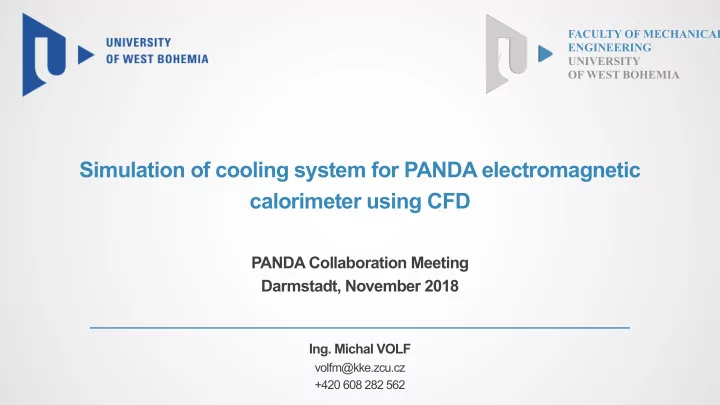

FACULTY OF MECHANICAL ENGINEERING UNIVERSITY OF WEST BOHEMIA Simulation of cooling system for PANDA electromagnetic calorimeter using CFD PANDA Collaboration Meeting Darmstadt, November 2018 Ing. Michal VOLF volfm@kke.zcu.cz +420 608 282 562
Department of Power System Engineering - CFD Ammonia-water solution-based heat exchangers Cogeneration units Complex geometries (reduction cages) Complex geometries (valves) 1D & 3D analysis (Nuclear Power Plant) Electrostatic precipitators of flue dust Turbomachinery 2
Introduction PbWO 4 light yield ↑↓ temperature lower temperature is better temperature stability within a single crystal ≈ 0.1 K among all crystals ≈ 1 K How can this be achieved? ? number of cooling tubes ! limited space for cooling circuits ? shape of cooling tubes ! crystals cannot be cooled down directly ? mass flow rate of cooling medium ! homogenous temperature field ? inlet temperature of cooling medium ! different pressure losses in each cooling circuit 3
First approach influence of fluid flow turning • partial geometry is used for simulation in order to: • decrease pre-processing time • decrease computational time FOAM COOLING TUBES influence of fluid flow turning SUPERMODULE7 MODULE 11 „representative“ crystals MODULE 10 numerical error computational domain should be extended to increase the number • of „representative“ crystals 4
Computational domain • ccomputational domain has been divided to two parts: base domain (crystals etc.) and cooling system • simplifies the procedure of testing multiple cooling systems • ensures the base domain is not influenced by changes in computational mesh BASE DOMAIN COOLING SYSTEMS • rectangular tubes • inner dim. 8 x 8 mm • two separate circuits • round tubes • inner diam. 8 mm • two separate circuits • SUPERMODULE 6 & 7 (modules 8 – 11) • domain consists of 150 crystals • 100 of them are considered as representative for the rest of SLICE connection 5
Numerical simulation setup heat transfer from applied as ambient temperature + heat Heat sources: ambient temperature 25 °C ambient air transfer coefficient (≈50 W/m 2 ) read-out electronics heat conduction in cables Cooling fluid: -28 °C, 0.4 kg/s at inlet pressure of 1 atm at outlet mixture of water/methanol (40/60) back wall is considered to be adiabatic heat source from symmetry specified on the chip (≈150 mW) outlet side walls inlet 2 outlet inlet 1 fixed temperature of -25 °C adiabatic wall 6
Material properties Specific heat Thermal conductivity Component Material Density [kg m -3 ] Other [W m -1 K -1 ] capacity [J kg-1 K -1 ] Crystals PbWO4 262 3.22 8280 Ref. temp. 30 °C Crystal casings Carbon fibres 1100 78.8 NaN Ref. temp. 120 °C Crystal connections Duralum 920 147 2900 Ref. temp. 25 °C APFEL asics Aluminium 903 237 2702 Ref. temp. 25 °C Electronic board holders Duralum 920 147 2900 Ref. temp. 25 °C Intermediate plates Duralum 920 147 2900 Ref. temp. 25 °C Supermodule plate Duralum 920 147 2900 Ref. temp. 25 °C Foam HOCOTOL 880 154 2830 Ref. temp. 25 °C Cooling tubes Copper 385 401 8933 Ref. temp. 25 °C Ref. temp. 25 °C Cooling medium Water/methanol (40/60) 3151 0.341 930 Ref. pressure 1 atm Ambient medium Ideal gas - - - - Material properties are NOT defined for operating temperature • needs to be reviewed General values are taken since we do not have specific material sheets available • 7
Material properties crystal connections the connection was modeled since there was no direct • connection in the default geometry 8
Preliminary results Temperature field – surface of the domain (without foam) Temperature field – surface of the crystals 9
Preliminary results – cooling system failures it is assumed that mass flow rate in the second circuits is only 5% of the mass flow rate in the first one • Temperature field – surface of the whole domain Temperature field – surface of the crystals 10
Conclusion Goal: cool down crystals to approx. - 25 °C ensure stability of temperature & homogenous temperature field Difficulties: complex geometry with lots of connections between components that are simulated as ideal ones lack of free space for proper cooling system 1D simplification of supermodules high accuracy of simulations sensitivity to boundary conditions difficulties with material properties at working temperature Follow-up research: result comparison between various cooling system designs VALIDATION OF PARTIAL RESULTS propose cooling design modifications simulate cooling system failures 11
FACULTY OF MECHANICAL ENGINEERING UNIVERSITY OF WEST BOHEMIA Thank you Ing. Michal VOLF +420 608 282 562 volfm@kke.zcu.cz
Recommend
More recommend